The Prince of Jihad is Dead. Will the Blind Sheikh’s passing create the first real National Security Crisis for Donald Trump?
 By Peter Lance February 18th, 2017. The Huffington Post
By Peter Lance February 18th, 2017. The Huffington Post
His New York cell planted a bomb on the B-2 level of The World Trade Center in 1993, killing six and injuring a thousand. He was convicted in 1995 as the centerpiece of the “Day of Terror” plot to blow up the bridges & tunnels into Manhattan, the U.N. and the FBI’s New York Office.
His imprisonment directly inspired the October 2000 bombing of the U.S.S. Cole in Yemen, which left seven U.S. sailors dead.
He was cited in the infamous Presidential Daily Briefing (PDB) to President George W. Bush in 2001 just, weeks before the 9/11 attacks, headlined “Bin Laden Determined to Strike in U.S.” and as recently as 2013, the terrorists who held a group of hostages at an Algerian gas plant, demanded his release.
This morning at 9:40 a.m. EST Sheikh Omar Abdel Rahman (OAR) the spiritual godfather of al Qaeda, reportedly died at the Federal Medical Center in Butner, NC where he’d been imprisoned for a decade.
On any normal Saturday when the U.S. national security apparatus was fully intact, his passing would be reason to worry. But today, after the abrupt exit of National Security Advisor Michael Flynn, with Vice Adm. Bob Harward, the leading candidate to replace him, turning down the job offer and credible reports of chaos in the White House, there should be grave cause for concern.
Why? Because Sheikh Omar was also the titular head of al-Gamma al-Islamiyya (the Islamic Group) one of the world’s most virulent terrorist organizations; responsible for the bloody 1997 Luxor massacre in which fifty-eight tourists and four Egyptians were murdered.
As far back as 2006 after Sheikh Omar suffered what the Feds called “a medical emergency” at the U.S. Federal prison in Springfield, Illinois, the FBI issued a threat bulletin warning that his death could prompt al Qaeda to launch a series of worldwide terror attacks against the U.S. in reprisal.
FATWA FOR A GRISLY BROOKLYN MURDER
Who was this mysterious man behind the dark glasses – an icon who may be more dangerous to the world in death than he was in life?
I tracked his trajectory in three books for HarperCollins published between 2003 and 2009 and became close to the man most responsible for putting him behind bars, former Egyptian Army officer and FBI informant Emad Salem who came a hair’s breath away from stopping the ‘93 WTC bombing.
As it turned out Salem became the first deep cover operative in the “war on terror,” spying for the FBI as he infiltrated the Sheikh’s New York cell. 
I chronicled his amazing exploits in a 2010 piece for Playboy that told of how, after he emerged from The Witness Protection Program, working his old jihadi contacts, Salem broke an infamous 19-year-old cold case with the help of ex-NYPD homicide detective James Moss. It was the 1991 Brooklyn murder of Mustafa Shalabi, an imam who preached at Brooklyn’s al-Farooq mosque, which had become a hotbed of radical activity in the early 90’s.
That death was far more bloody and brutal than any Mafia execution and as Det. Moss and Salem worked the case, they discovered that the man who ordered the “hit” was none other than Omar Abdel Rahman, who had held forth himself at a Jersey City mosque, ironically called al-Salaam — the “mosque of peace.”
As you’ll see below, that mosque located on the third floor of a commercial building on Kennedy Boulevard, was a kind of jihadi junction box, which, if properly monitored by The Bureau, could have led FBI agents right into the middle of the 9/11 plot in the summer of 2001, months before “Black Tuesday.”
In any case, when it comes to Sheikh Omar, many of the most historic and catastrophic events in the rise of jihadi violence, lead directly back to him.
THE PRINCE OF JIHAD
Blinded shortly after birth, OAR had memorized the Koran by the age of eleven. He earned a degree in Koranic studies in 1972 from the Al Azhar University in Cairo, where he was influenced by the writings Sayyid Qutb, the Egyptian intellectual who was an ardent member of The Muslim Brotherhood. Founded in 1928, The Brotherhood spawned two of Egypt’s most violent terror sects: The Islamic Group run by Sheikh Omar, and the Egyptian Islamic Jihad led by Dr. Ayman al-Zawahiri. 
Both Abdel Rahman and al-Zawahiri were jailed following the 1981 assassination of Anwar Sadat and by separate routes, the two of then found their way to Afghanistan; al-Zawahiri aligning with Osama bin Laden to form al Qaeda in 1988 and Sheikh Omar connecting with Gulbuddin Hekmatyar, a warlord and future Taliban commander who became one of the conduits for the billions in U.S. covert military aid to the Mujahedeen.
On his return to Egypt in 1990, the blind Sheikh was subjected to house arrest, but he escaped to the Sudan and despite his presence on multiple watch-lists, succeeded in entering the U.S. in July, thanks, some say, to help from the CIA for his aid in the secret Afghan arms campaign.
Abdel Rahman was soon preaching at the al Farooq on Atlantic Avenue and the Masjid al-Salaam at 2824 Kennedy Boulevard in Jersey City and before long he was linked directly to two violent homicides.
THE FIRST BLOOD
On November 5, 1990, one of Abdel Rahman’s devoted followers, an Egyptian emigré named El Sayyid Nosair, committed arguably the first act of violence by al Qaeda on U.S. soil – the bloody assassination of Rabbi Meir Kahane, founder of The Jewish Defense League. I told that story in depth in a 2010 piece for Tablet Magazine.
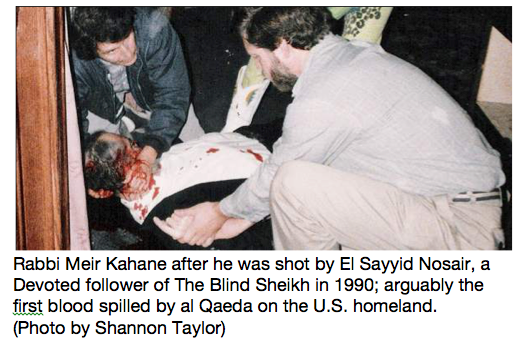 After the killing, FBI agents seized forty-seven boxes of evidence from Nosair’s home in Cliffside Park, New Jersey, proving that a bombing conspiracy was afoot with the WTC as a target.
After the killing, FBI agents seized forty-seven boxes of evidence from Nosair’s home in Cliffside Park, New Jersey, proving that a bombing conspiracy was afoot with the WTC as a target.
Among the files were maps of the Twin Towers. There was also a passage inside Nosair’s notebook calling for the “destruction of the enemies of Allah… by… exploding… their high world buildings.”
The Feds later proved that the blind Sheikh was the ringleader of the cell behind the bombing; demanding, in one of his sermons that his followers “mount steeds of war (and) strike terror into the enemies of Islam.”
THE NEXT MURDER
Rahman soon began to quarrel with Shalabi, the Egyptian émigré who ran the Alkifah Center at the al-Farooq mosque. The Alkifah was the principal U.S. office of the Makhtab al-Khidamat (MAK), a worldwide network where millions of dollars in cash was collected to support the Afghan war against the Soviets.
After the MAK’s founder was killed by a car bomb, Osama bin Laden and Dr. al-Zawahiri merged their new terror network with the MAK and soon al-Qaeda had what amounted to a New York clubhouse at Shalabi’s Center.
But even after the Soviets had withdrawn from Kabul, hundreds of thousands of dollars in cash continued to flow into the MAK and it didn’t take long for Sheikh Omar to covet the fortune controlled by Shalabi.
Though the red-headed Egyptian had sponsored Sheikh Omar’s entry into the United States, he balked when the blind cleric demanded half of the center’s one million dollars in annual income. After that, the Sheikh began denouncing him as a “bad Muslim;” even suggesting the imam was embezzling the Alkifah’s funds.
On February 26, 1991, sensing that his life was in danger, Shalabi hurriedly packed for a flight to Cairo, where his family was waiting. He never made it to the airport. A few days later, a neighbor noticed that the door to his Sea Gate, Brooklyn apartment was open. The Alkifah director was sprawled on the floor in a pool of blood. 
“He was knifed, shot and beaten with a baseball bat,” said the late Joint Terrorism Task Force investigator Det. Tommy Corrigan. “This wasn’t some genteel thing. He was made an example of.”
CONNECTING THE DOTS ON 9/11
With two acts of homicide linked to the blind Sheikh within a year of his arrival in New York, the FBI soon uncovered a pattern of evidence that, properly analyzed, might have forewarned of the September 11th attacks a decade later.
I laid it out in a 32 page illustrated timeline inserted into “1000 Years For Revenge,” my first book for HarperCollins on the origins of the 9/11 plot.
The first “dot” linking Sheikh Omar’s New York cell to the “planes as missile” plot surfaced back in the early 90’s when the Feds identified Sphinx Trading, a check-cashing store in Jersey City where both Sheikh Omar and El Sayyid Nosair had mailboxes. Sphinx was located in a building on Kennedy Boulevard several doors away from the blind cleric’s al-Salaam mosque.
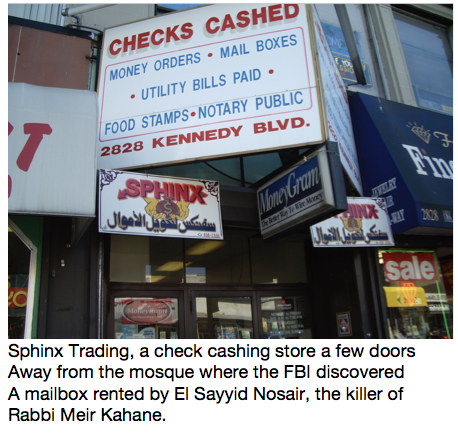 The second “dot” became known in 1994 after the feds compiled a list of 172 un-indicted co-conspirators in the “Day of Terror” case in which the Sheikh and eleven others were indicted for that plot to blow up the bridges and tunnels into Manhattan, the U.N. and 26 Federal Plaza which houses the FBI’s New York Office (NYO).
The second “dot” became known in 1994 after the feds compiled a list of 172 un-indicted co-conspirators in the “Day of Terror” case in which the Sheikh and eleven others were indicted for that plot to blow up the bridges and tunnels into Manhattan, the U.N. and 26 Federal Plaza which houses the FBI’s New York Office (NYO).
Named on that list along with Osama bin Laden and Mustafa Shalabi was Waleed Abu al-Noor, co-incorporator of Sphinx Trading.
Flashing forward to July of 2011 and the third “dot” — Khalid al-Midhar and Salem al-Hazmi, two of the hijackers who flew American Airlines Flight 77 into the Pentagon, obtained the fake I.D.’s they used to board that flight at Sphinx Trading. Who did they get them from? None other than Mohamed El-Attriss, another Egyptian who was al-Noor’s partner in the incorporation of the check-cashing store.
That begs the question of how the two “bin Laden offices of origin” — the FBI’s NYO and the Office of the U.S. Attorney for the Southern District of New York (SDNY) — could have failed to connect those dots; two of which bore a direct connection to Omar Abdel Rahman. 
As far back as November, 2006 with the publication of my third book from HarperCollins “Triple Cross,” I made the argument that if the Feds had only devoted a small portion of the resources they spent trying to “get” John Gotti, and monitored Sphinx Trading, they would have been in the middle of the 9/11 plot two months before al-Midhar and al-Hazmi slammed into The Pentagon.
The connection of those three dots around Sphinx Trading takes on new significance when one considers the other iconic acts of terror committed in Sheikh Omar’s name since the 1993 bridge and tunnel plot.
A RALLYING POINT FOR JIHADIS
Beginning in 1996, the FBI received the first of three warnings that bin Laden would attempt to hijack a plane to free the Sheikh.
When al-Qaeda took credit for the bombings of the U.S. Embassies in Kenya and Tanzania in 1998, Sheikh Omar’s release was one of their demands.
Weeks before the attack on the U.S.S. Cole in October 2000, al-Zawahiri and bin Laden appeared in a video fatwa, demanding that the Sheikh be set free.
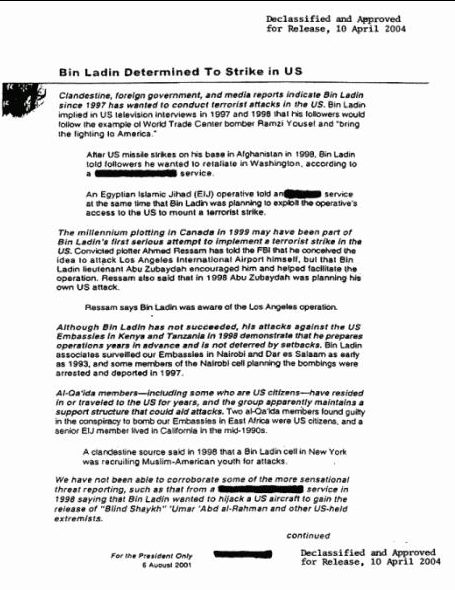 Another plot to release him was cited in that infamous Crawford, Texas PDB and just days before the 9/11 attacks, the Taliban government in Kabul was rumored to be offering a swap — the group of eight Western aid workers being held captive, for the Blind Sheikh.
Another plot to release him was cited in that infamous Crawford, Texas PDB and just days before the 9/11 attacks, the Taliban government in Kabul was rumored to be offering a swap — the group of eight Western aid workers being held captive, for the Blind Sheikh.
As late as April 22, 2005, in entering a guilty plea, Zacarias Moussaoui, the so-called “twentieth hijacker,” declared that his goal in the aborted plan to fly a plane into the White House was to free Omar Abdel Rahman.
RASPUTIN-LIKE RESILIENCE
Until his death today, the blind cleric, in federal prison since 1993, has demonstrated extraordinary staying power. In December 2006, at the time of that FBI threat warning, he was diagnosed with a tumor on his liver and rushed to a Springfield, IL area hospital after spitting up blood. It was believed at the time that he was near death.
Then, exhibiting a kind of Rasputin-like resilience, he not only pulled through, but began to thrive. He was eventually moved to the prison-medical facility at Butner, NC where, by the summer of 2012, his continuing influence on world events became clear.
IMPACTING THE EGYPTIAN ELECTION
In 2009 following a lecture I gave at NYU, Emad Salem, reached out to me after years in the WITSEC program. He and his family had to go into hiding, protected by the U.S. Marshals, after he’d served as the linchpin witness against the Sheikh in the “Day of Terror” trial. Now he was ready to tell his story. 
During a series of interviews Salem told me about a key piece of evidence in the Mustafa Shalabi homicide that had never surfaced in the media. That prompted the NYPD to reopen the investigation.
As a result, the Feds produced a series of FBI 302 memos identifying the killers, along with a second gunman in the Kahane assassination. The details were so ground-breaking that The Jerusalem Post did a page one story on my findings, which included the revelation that Ariel Sharon, Israel’s former prime minister, had been one of Nosair’s initial targets.
Since then, while continuing to live under an assumed identity, Salem has regularly monitored the political events in Egypt.
A FATWA FROM PRISON
On May 30, 2012 on the eve of the Egyptian presidential election, Salem alerted me that the website maintained by Sheikh Omar’s family had issued a political fatwa from the imprisoned cleric endorsing the election of Mohamed Morsi.
In that admonition, the blind sheikh reminded “every Muslim and citizen of Egypt who fears about his country, that he or she must elect Dr. Morsi, since he is the one representing Islam the most and representing the Revolution.”
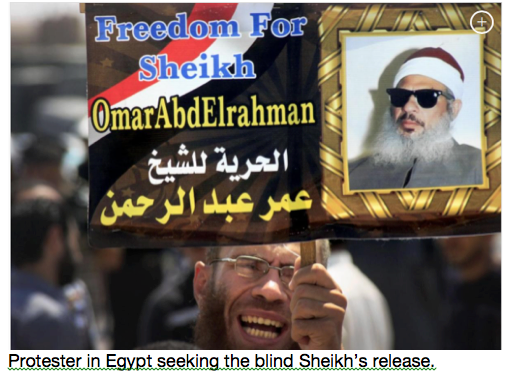 For months prior to the election, followers of the Blind Sheikh had been camped outside the U.S. Embassy in Cairo, demanding his release. Now they were rallying in Tahrir Square. The day after Morsi’s narrow victory, Emad Salem discovered that Sheikh Omar, who was supposed to get a single, fifteen-minute “humanitarian” call to his family each month, was able to make a second call; this time congratulating the president-elect.
For months prior to the election, followers of the Blind Sheikh had been camped outside the U.S. Embassy in Cairo, demanding his release. Now they were rallying in Tahrir Square. The day after Morsi’s narrow victory, Emad Salem discovered that Sheikh Omar, who was supposed to get a single, fifteen-minute “humanitarian” call to his family each month, was able to make a second call; this time congratulating the president-elect.
Then, within days of his election, at a rally in front of Abdel Rahman’s family, Morsi returned the favor by declaring that he would press for the freedom of Sheikh Omar and other terrorists convicted in the United States.
BREITBART HEADLINES
After Morsi’s call for the Sheikh’s release, the issue became a cause célèbre on the U.S. political right. “U.S. State Dept. Considers Release of Blind Sheikh to Egypt” was the headline on Breitbart.com in September, 2012.
Two days later, The New York Post ran a story referencing President Obama titled, “O Eyes ‘Blind Sheik’ Release: GOPers Blast Idea to Appease Egypt.” Another Breitbart story was headlined “Egypt Pres To Obama: Free Terrorist Blind Sheikh.” 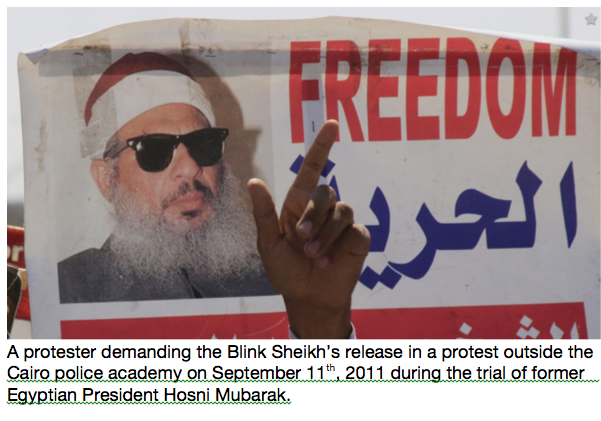
In response, then Secretary of State Hillary Clinton made it clear that the Sheikh had been rightfully convicted and she emphatically denied that the United States had plans to extradite him.
“What happened in New York twenty-three ago,” says Emad Salem, “is still causing blood to be spilled in the Middle East and threatening U.S. security. The Sheikh was the prince of jihad and even from inside a prison cell he wielded tremendous power.”
Just today he told me that the Sheikh’s family was asking the Trump Administration to release Abdel Rahman’s body and return it to Egypt.
“They want to build a shrine for him there, in his birthplace of Fauom,” he said. “That will make him a martyr for the Islamic terrorist resistance. It will become a rallying point for jihadis all over the world. I have personally urged President el-Sisi not to accept the body so as to deprive the fanatics of having such a focal point for their hate.”
Now as the President spends his third weekend at Mar-a-Lago, if the followers of the Blind Sheikh make good on their threats from a decade ago, Donald Trump and his Special Counsel Steve Bannon, who was executive chairman of Breitbart News at the time those headlines were written, could get a taste of what an international crisis really looks like.



Recent Comments